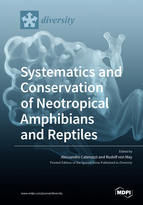Systematics and Conservation of Neotropical Amphibians and Reptiles
A special issue of Diversity (ISSN 1424-2818). This special issue belongs to the section "Animal Diversity".
Deadline for manuscript submissions: closed (30 June 2019) | Viewed by 121730
Special Issue Editors
Interests: conservation biology; ecology; biodiversity; amphibian biology; herpetology
Special Issue Information
Dear Colleagues,
Systematic and taxonomic studies are essential for conservation – we can only preserve what we know. The first step of knowing organisms is to identify species, and to name and organize them according to their evolutionary history. The number of species of amphibians and reptiles has increased sharply over the last few decades, but we have much work ahead of us if we want to describe the outstanding biodiversity of the Neotropical herpetofauna. At the same time, traditional and emergent threats are accelerating the erosion of herpetofaunal biodiversity. Traditional threats include habitat loss, pesticides, and over-harvesting of wild populations. Emergent threats such as disease and climate change may impact species within natural protected areas where habitat loss and fragmentation are negligible. Emergent infectious diseases, such as chytridiomycosis, are associated with population declines and the collapse of amphibian communities throughout the Neotropics. Additionally, while climate change threatens many amphibian and reptilian species, it remains unclear how species will be able to cope with increasing temperatures, seasonal shifts and increasing frequency of extreme climatic events. The purpose of this special issue is to gather original studies focusing on herpetological systematics and conservation. We welcome contributions focusing on any Neotropical group of amphibians and/or reptiles, and which use original data or modeling of available data, aimed at improving the use of systematic and taxonomic knowledge for conservation. We also encourage papers proposing new methods to accelerate taxonomic studies, including those that present technological advances to quickly generate molecular data. This special issue will be open to all facets of conservation, ranging from applied conservation (i.e., to improve captive breeding programs, help design protected areas, or to design education projects) to policymaking and assessments of species threat status. We especially encourage reports of successful conservation initiatives that rely on the use of newly generated taxonomic information.
Dr. Alessandro Catenazzi
Dr. Rudolf von May
Guest Editors
Manuscript Submission Information
Manuscripts should be submitted online at www.mdpi.com by registering and logging in to this website. Once you are registered, click here to go to the submission form. Manuscripts can be submitted until the deadline. All submissions that pass pre-check are peer-reviewed. Accepted papers will be published continuously in the journal (as soon as accepted) and will be listed together on the special issue website. Research articles, review articles as well as short communications are invited. For planned papers, a title and short abstract (about 100 words) can be sent to the Editorial Office for announcement on this website.
Submitted manuscripts should not have been published previously, nor be under consideration for publication elsewhere (except conference proceedings papers). All manuscripts are thoroughly refereed through a single-blind peer-review process. A guide for authors and other relevant information for submission of manuscripts is available on the Instructions for Authors page. Diversity is an international peer-reviewed open access monthly journal published by MDPI.
Please visit the Instructions for Authors page before submitting a manuscript. The Article Processing Charge (APC) for publication in this open access journal is 2600 CHF (Swiss Francs). Submitted papers should be well formatted and use good English. Authors may use MDPI's English editing service prior to publication or during author revisions.
Keywords
- frogs
- salamanders
- caecilians
- lizards
- snakes
- turtles
- crocodilians
- taxonomy
- phylogenetics
- ecology







